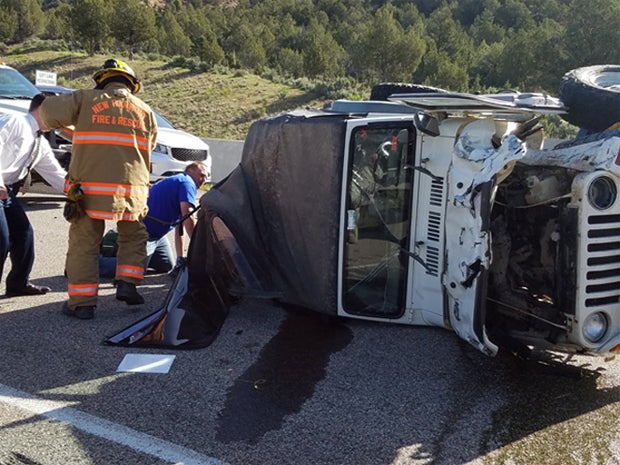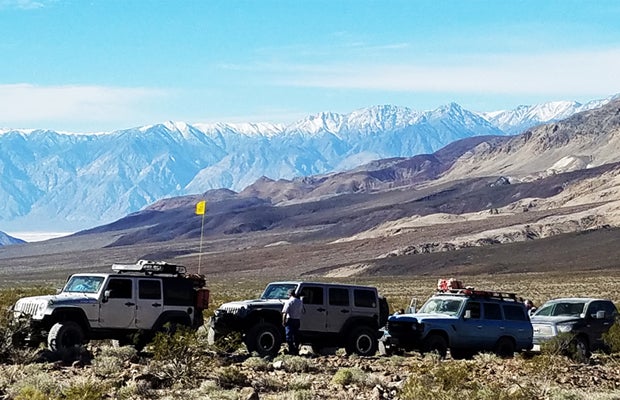
We were returning from the Easter Safari at Moab. It was a nice drive that Saturday: sunny and warm but gusty. Soon after turning onto I-15, my radio crackled. Tim, one of my friends, excitedly reported a “major accident” involving a vehicle that had just passed him in the fast lane.
Caught by a sudden gust of wind, the Jeep careened into the cement retaining wall in the median, then bounced off into the guard rail on the other side, flipping several times in the process. Tim managed to narrowly miss being involved in the carnage.
I stopped as quickly as I could. Grabbing my first aid bag, I hurried to the scene. The Jeep came to rest on its side, with the roll bar pinning the driver underneath.
As I began my initial assessment, I glanced up and saw Tim. Reaching the vehicle first, he had made sure 911 was called, stopped traffic, turned off the vehicle, and checked if there was a possible passenger. “I felt so hopeless,” Tim said. “I did everything I could but I had no idea what to do medically.”
Value of Wilderness First Aid Class
Tim’s response was very typical (and I don’t mean that in a critical way). Without the proper training, individuals don’t know what to do when they come upon an accident or other serious incident. I am certified as a Wilderness First Responder and have taken numerous recertification classes over the years. So, my reaction was somewhat more measured based on a plan drilled into us.
This incident reinforces/emphasizes the value for four-wheelers — really, anyone — to learn first aid skills. And because four-wheeling takes place in remote areas, I suggest participants take the Wilderness First Aid class. An added benefit is that this training hold you in good stead in urban areas, as well.
At the time of the accident, we were about 45 miles from the nearest community with a trauma hospital (St. George, Utah). Recall that our definition of wilderness is any place two or more hours away from definitive medical care. We weren’t at that distance this time, but it was still a significant distance. Authorities didn’t take any chances: They dispatched a helicopter to the scene.
Wilderness Medical Associates teach a Patient Assessment System that contains a 3-step process to evaluating an injury or medical emergency. I will tell you a bit about it but this article can in no way substitute for hands-on training.
Scene Size-Up
The first step is an assessment of the scene. Though you’re eager to help, don’t go rushing in. Spend a moment just observing. You’re looking for hazards that could endanger your life and anyone else’s. These include downed power lines or a vehicle on a precarious angle that could roll over on you.
When making your initial scene assessment, determine the method of injury (MOI). The three categories are trauma, medical and environmental. Although some incidents fall under more than one category, there is a predominant MOI.
Trauma refers to significant injury such as the car accident we saw. Heart attacks & strokes are considered medical conditions. Environmental incidents include severe allergic reactions (bee stings, for example), heat strokes, hypothermia and even asthma attacks.
Determine how many patients, how many rescuers, and bystanders, etc.

Primary Assessment
Next, perform an assessment of the patient. Using the BLS (basic life support) protocol, you check circulation, respiration and the nervous system. Find any issues that will kill your patient if not fixed right now – e.g. not breathing, severe bleed. A broken arm is not urgent if he is not breathing.
Note any obvious bleeding or injuries. If possible — and with gloved hands — inspect the victim thoroughly for severe bleeding.
In the above incident, the driver was talking and moving about. It was apparent he was conscious and breathing, and (most likely) did not have a spinal cord injury but not worth taking a chance. Spinal injuries, by the way, are a big concern in vehicle crashes or other violent incidents. Try to keep the patient still. People often want to get up and move around. Unless they’re in imminent danger — say, the vehicle is on fire or they’re in traffic — keep the person still.
In an urban environment with EMS on the way, BLS is about all you can and have time to do. In a wilderness context, you move to the next step. You delay calling for help until you complete the secondary assessment so you know what help is needed and the level of urgency.
Secondary Assessment
The third step is known as a secondary assessment. There are three major parts. They are not always done in a specific sequence. The situation may dictate which step you do first.
At this stage, you’re trying to get more information from the victim. Details such as medicine they’re on, allergies, symptoms, pertinent medical history, what they recall about the incident, so forth. All useful information in determining your action plan and anticipated problem.
On my problem list was:
MOI spine - anticipated problem spinal cord injury:
MOI Internal injuries – anticipated internal bleeding;
Traumatic brain injury (TBI) – anticipated increasing internal cranial pressure (ICP);
Broken right arm – anticipated problem nerve and circulator issue;
and the weather (cool & windy) – anticipated hypothermia.
In the secondary assessment stage, you have time to check vital signs (pulse, respiration, level of consciousness, etc.) at regular intervals. Vital signs are one of a few tools we have in the field to determine what is going on inside the body.
And you have time for a physical exam head to toe. Inspect, listen, and palpate (means touch). Find out where it hurts or tender and to what extent.
Addendum
EMT showed up in 16 minutes with the helicopter just a few minutes behind. I briefed the EMT and left. He was flown to St George for care. I never found out the results.
Where to Find a First Aid Class
First aid classes, among other training, are offered by a host of organizations. Two I’m familiar with are Wilderness Medical Associates (WMA) and National Outdoor Leadership School. Courses run from two to nine days. A two-day course is a good starter. I have taken numerous courses through WMA, and highly recommend their programs.
Incidentally, I am sponsoring a Wilderness First Aid Course on June 3 and 4 2017. An instructor from WMA will teach the class. You receive hands-on training in the patient assessment system. This is a good opportunity for you to get your first aid and CPR certification as the summer four wheeling season begins.
An emergency can occur anywhere and at any time. A two-day wilderness first aid course, though covering only the basics, give you the skills and confidence to assist in many situations. Whether my course this June or one offered by another organization, I highly encourage you to sign up. And take your spouse along. The more people in your family who get this valuable training, the better.
MORE TRAIL TIP STORIES
How to Replace U-Joints on Your 4x4
Trail Tips: What Causes Washboard Roads?
Cooking with a Dutch Oven on the Trail
Badlands Off-Road Adventure
Off-road trainer Tom Severin shares insight and tips on a variety of topics related to preparing you for that next off-road adventure. With over 40 years of off-road experience, Severin operates under his business Badlands Off-Road Adventures. He is a certified professional 4WD Trainer by the International 4-Wheel Drive Trainers Association and a Wilderness First Responder (WFR). He is a member of the California Association of Four Wheel Drive Clubs (CA4WDC), United Four Wheel Drive Associations and the BlueRibbon Coalition. He also is a certified UFWDA and a CA4WDC 4WD instructor.
For more information about Badlands Off-Road Adventures, visit 4x4training.com.
http://www.4x4training.com/.


 Your Privacy Choices
Your Privacy Choices